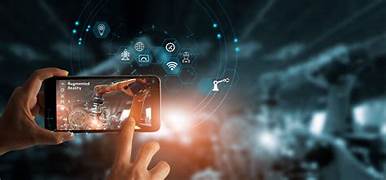Augmented reality (AR) is a technology that superimposes a computer-generated image on a user’s view of the real world, thus providing a composite view. AR has applications in many fields, including entertainment, education, gaming, manufacturing, and healthcare.
How does AR work?
AR works by using a device, such as a smartphone or tablet, to display computer-generated images over a user’s view of the real world. The device uses sensors, such as a camera and a GPS receiver, to track the user’s position and orientation in the real world. The device then uses this information to overlay the computer-generated images in the correct location.
Types of AR
There are two main types of AR: marker-based AR and markerless AR. Marker-based AR requires the user to place a physical marker in the real world. The device then uses the marker to track the user’s position and orientation. Markerless AR does not require the user to place a physical marker in the real world. The device uses the surrounding environment to track the user’s position and orientation.
Benefits of AR
AR has many benefits, including:
- Increased productivity: AR can be used to increase productivity in a variety of industries. For example, AR can be used by surgeons to guide them during surgery, by factory workers to assemble products, and by pilots to fly airplanes.
- Enhanced learning: AR can be used to enhance learning in a variety of settings. For example, AR can be used by students to learn about anatomy, by employees to learn about new products, and by tourists to learn about historical landmarks.
- Improved customer service: AR can be used to improve customer service in a variety of industries. For example, AR can be used by retailers to help customers find products, by restaurants to help customers order food, and by hotels to help customers find their rooms.
Challenges of AR
AR also has some challenges, including:
- Cost: AR devices can be expensive.
- Complexity: AR devices can be complex to use.
- Battery life: AR devices can have short battery lives.
- Privacy: AR devices can raise privacy concerns.
Future of AR
The future of AR is bright. AR is expected to grow rapidly in the coming years. AR is expected to be used in a variety of applications, including:
- Gaming: AR is expected to be used in gaming to create more immersive and interactive experiences.
- Education: AR is expected to be used in education to provide students with a more engaging and interactive learning experience.
- Manufacturing: AR is expected to be used in manufacturing to improve productivity and safety.
- Healthcare: AR is expected to be used in healthcare to provide doctors and patients with a more immersive and interactive experience.
AR is a powerful technology with the potential to revolutionize many industries. As AR technology continues to develop, we can expect to see even more innovative and exciting applications for AR in the future.
Here are some examples of how AR is being used today:
- Gaming: Pokémon Go is one of the most popular AR games. In the game, players use their smartphones to find and catch Pokémon in the real world.
- Education: The Khan Academy app uses AR to help students learn about math and science concepts. The app overlays 3D models and animations on top of real-world objects, making it easier for students to understand complex concepts.
- Manufacturing: Boeing uses AR to help its engineers design and build airplanes. The company’s AR system allows engineers to see 3D models of airplanes in real time, which helps them to identify and correct errors early in the design process.
- Healthcare: Surgeons are using AR to perform complex surgeries. The technology allows surgeons to see 3D models of patients’ bodies in real time, which helps them to make more precise incisions.
These are just a few examples of how AR is being used today. As the technology continues to develop, we can expect to see even more innovative and exciting applications for AR in the future.














